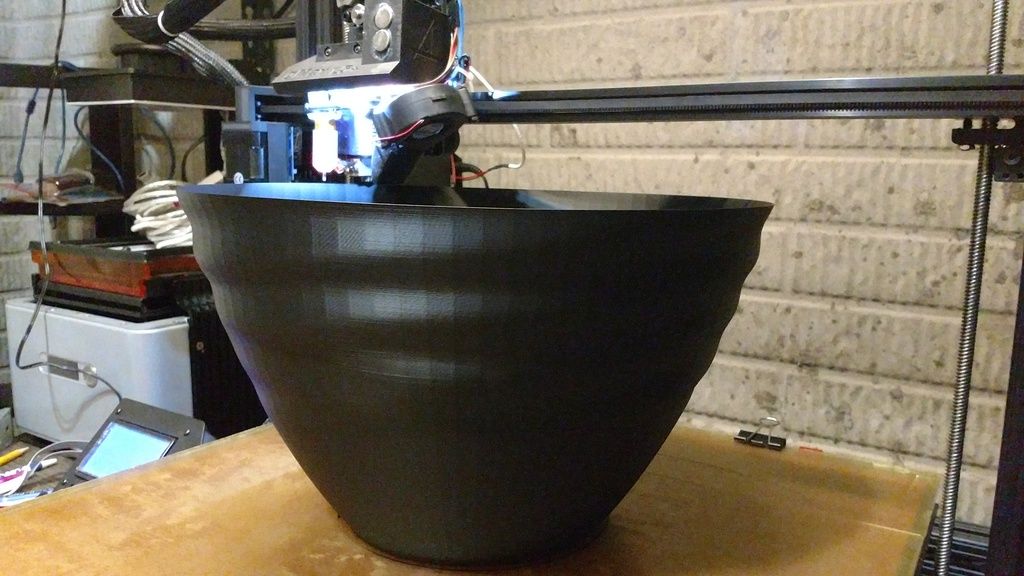My art involves designing lots of objects for homes. I play with light and textures, and I print at architectural scales. Though I may prototype at “standard” scale, the gMax is my tool of choice (and only option) for printing at full scale with fit, finish and polish.
Kyle and I worked through an issue related to a wobble that showed itself in a decanter-like test object that I used during my initial shakeout of the gMax. In particular, I discovered that the gantry belt hadn’t been sufficiently tightened during assembly. But the wobble disappeared after I tightened it. But in the course of running other tall, wide and thin-walled geometries the wobble returned. I want to share my thoughts on what I think is causing it.
I ran several tests when the printer would otherwise be powered off. A photo of one of these tests is below. As can be seen, the wobble doesn’t exhibit at the very bottom of a print. This test object tapers outwardly and then back in at the top. I made sure the gantry and bed belts were both tight before starting that job. I think the wobble on this print is particularly bad because the job was laid out using S3D’s Vase Mode. So the walls are VERY thin.
So if this isn't caused by slop in the belts, what's causing it? Does it show itself because the circumference is greater or because printing is happening far above the bed?
My take is that the root cause is distortion of the print. This distortion is caused by the pull on the object that results from the viscosity of the filament being extruded. The tall, (very) thin walled object is being pulled out of true. So the newest layer settles and cools on the layer below it slightly off center from where it should be. As successive layers are also laid down off-center, the harmonic begins to swing in the other direction because the lower layers aren’t where they should be. So the system presents itself as a series of wobbles.
Some more evidence worth noting is that a single shell vase cylinder having a 10mm radius and 400mm height that I printed did not develop a wobble. This tells me that it’s not being caused by a loose belt or a frame that has too much flex. The straight wall and pure, circular profile provided enough object rigidity that each layer was laid down directly on top of the one below.
I wish my tall, thin prints weren’t coming out with a wobble. And I’ll continue to experiment looking for a solution. (Higher extruder temps?) But I don’t believe it’s the printer itself. In fact, the surface quality of that 400mm cylinder is very good all the way up. I’m impressed.
- Bob
Kyle and I worked through an issue related to a wobble that showed itself in a decanter-like test object that I used during my initial shakeout of the gMax. In particular, I discovered that the gantry belt hadn’t been sufficiently tightened during assembly. But the wobble disappeared after I tightened it. But in the course of running other tall, wide and thin-walled geometries the wobble returned. I want to share my thoughts on what I think is causing it.
I ran several tests when the printer would otherwise be powered off. A photo of one of these tests is below. As can be seen, the wobble doesn’t exhibit at the very bottom of a print. This test object tapers outwardly and then back in at the top. I made sure the gantry and bed belts were both tight before starting that job. I think the wobble on this print is particularly bad because the job was laid out using S3D’s Vase Mode. So the walls are VERY thin.
So if this isn't caused by slop in the belts, what's causing it? Does it show itself because the circumference is greater or because printing is happening far above the bed?
My take is that the root cause is distortion of the print. This distortion is caused by the pull on the object that results from the viscosity of the filament being extruded. The tall, (very) thin walled object is being pulled out of true. So the newest layer settles and cools on the layer below it slightly off center from where it should be. As successive layers are also laid down off-center, the harmonic begins to swing in the other direction because the lower layers aren’t where they should be. So the system presents itself as a series of wobbles.
Some more evidence worth noting is that a single shell vase cylinder having a 10mm radius and 400mm height that I printed did not develop a wobble. This tells me that it’s not being caused by a loose belt or a frame that has too much flex. The straight wall and pure, circular profile provided enough object rigidity that each layer was laid down directly on top of the one below.
I wish my tall, thin prints weren’t coming out with a wobble. And I’ll continue to experiment looking for a solution. (Higher extruder temps?) But I don’t believe it’s the printer itself. In fact, the surface quality of that 400mm cylinder is very good all the way up. I’m impressed.
- Bob

